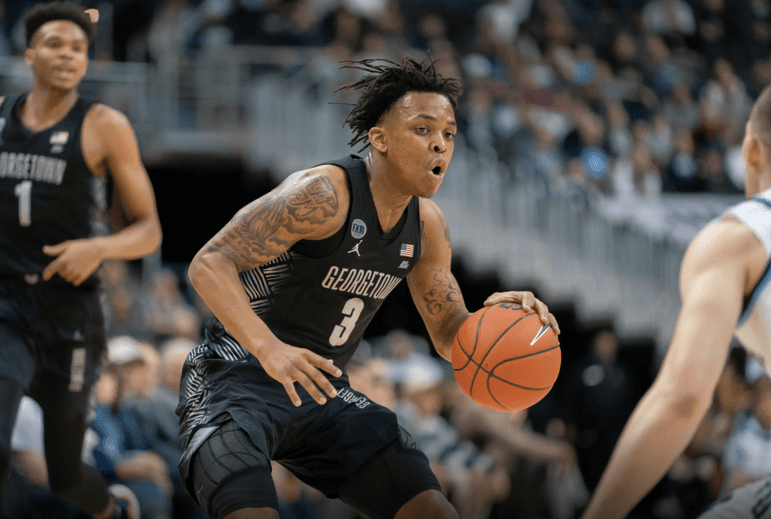In the Midst of March Madness
By • March 18, 2019 0 898

Sunday, March 17, was March Madness, in more ways than one.
For the Irish and those who have an affinity for all things Irish — the wearing of the green, Irish rebel songs, Maureen O’Hara, reading James Joyce out loud, fake freckles, Guinness stout and tall tales in faux Gaelic — it was St. Patrick’s Day. Which meant Washington restaurants and bars catering to the Irish year-round, from Billy Martin’s Tavern in Georgetown to the Dubliner near Union Station, had a fabulous day and a late night to celebrate.
For fans and superfans of college basketball of all ages, this was the day and night of reckoning, followed by Monday morning analysis, the official opening of March Madness, hoops-style, with the announcement of the pairings and brackets for the 68-team 2019 NCAA Basketball Tournament, a list of them that made it and them that didn’t.
It also came with the news earlier that yet another candidate had entered the race for the Democratic basketball — I mean presidential — nomination. Who knows? By the time the tournament has crowned a champion some weeks hence, there might be more candidates than initial basketball entrants.
Be that as it may, this year’s tournament entrants, featuring conference tournament champion winners, at-large entrants chosen by committee based on often puzzling and mysterious standards, had an oddly familiar feeling to it, as if we were about to relive a lifetime of tournaments, while welcoming some odd and unfamiliar new entrants who may or may not cause trouble for the top-ranked and high-seeded favorites.
And don’t tell me those things can’t happen. They happen only all of the time. Let that be a lesson to the Virginia Cavaliers, who are seeded number-one in the South Regionals, although not number-one overall, which was their singular honor ahead of last year’s tournament. The Cavs came up with another singular honor right off the bat when they lost to UMBC or University of Maryland Baltimore County — by a whopping 74-54 — in the round of 64.
It’s not too radical to say that the result was an embarrassment to Virginia and in Virginia, since that was the first time a number-one seed had lost to a number-16 seed. So, unless you were picking your bracket choices on a roll of the dice, the result just about busted almost every bracket being carefully chosen on the basis of track record, school size, talent and the usual strength of schedule. Many television anchors, including weather analysts, complained at the time about tearing up their choices.
Virginia is back with another stellar team, and will play another team unheralded and virtually unnoticed, a team from a college named Gardner-Webb, the Runnin’ Bulldogs from Boiling Spring, North Carolina, competing in the Big South Conference. The Cavaliers sport a 29-3 record, something similar from last year’s high hopes, but probably won’t be overconfident, nor should they be, having lost to Florida State in the ACC Conference Tournament.
But enough about the Cavs — they’re not the only familiar teams in the tournament. Duke, and the perennial among supercoaches Mike Krzyzewski, is clearly the number-one seed with an all-star cast (Zion Williamson is back), a complete team and a history that includes Duke-trained coaches all over the land.
You want more familiar? Gonzaga is a perennial entrant and this time is a top seed in the West, and North Carolina features another durable, high seniority coach in the venerable Roy Williams, leading a team that has already beaten Duke once. Plus, there’s the Michigan State Spartans coached by the wily Tom Izzo, who knows how to win in these things, as in the same regional as Duke.
Want some locals? Maryland is one of them, a sixth seed in the East Regional, will play the winner of a play-in game, but anything can happen. The Terps haven’t been very lucky in the tournament of late, and didn’t make anybody optimistic after losing to Nebraska in the Big Ten Tournament, in spite of a 22-10 record under coach Mark Turgeon.
One team that didn’t make the NCAA tournament was Georgetown University under second-year coach Patrick Ewing, which will have to take solace in a trip to the National Invitational Tournament, in spite of a solid 19-13 record. They’ll face Harvard on Wednesday, March 20.
The presence of the Hoyas in the NIT, and for that matter the host of familiar coaching names in the NCAA tournament, lets you indulge in a bit of nostalgia. Georgetown, under John Thompson, once appeared in three NCAA championships, beating Houston and losing to North Carolina and Villanova in two classic games in which Ewing was a prominent and key star feature of the team.
We’ve seen classic Duke defeats and Duke wins, and an NCAA championship on the part of the Maryland team of coach Gary Williams, and we’ve seen George Mason’s fabled run into the Final Four not so long ago. We’ve seen buzzer-beaters, underachieving favorites and overachieving underdogs and duels between legends like Larry Bird and Magic Johnson.
Today’s game and tournament feels both old and new, with its expanded field, the inclusion of teams from midsized conferences, with its often faster style and emphasis on the three-point shot, although defense, if you check the scores this past regular season, seems to play a big part, which should help Virginia.
Change, of course, comes to everything, but a tournament like this brings the past with it, flavors the proceedings. As last year showed, anything can still happen. Take note Duke. And Maryland fans, watch out for the Maryland women’s team, who stand a good shot of going deep in the women’s tournament, where it’s no longer Connecticut and everyone else.
For the rest — have your brackets at the ready, read them and weep or rejoice. It’s March Madness time.
Sunday was March Madness, in more ways than one.

